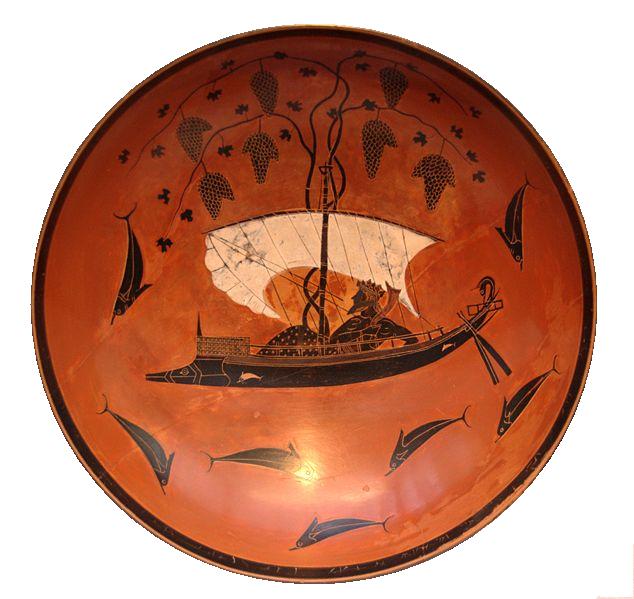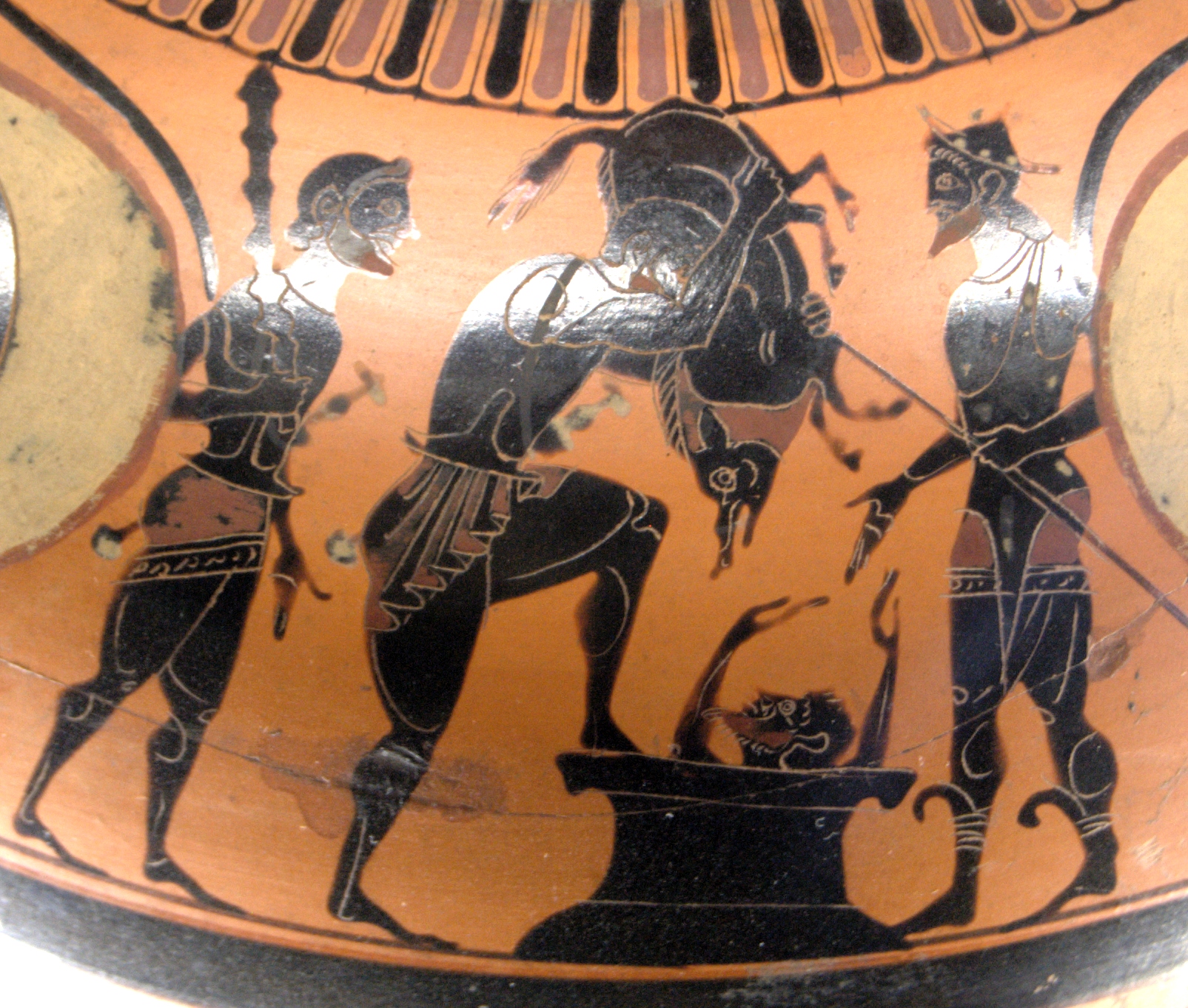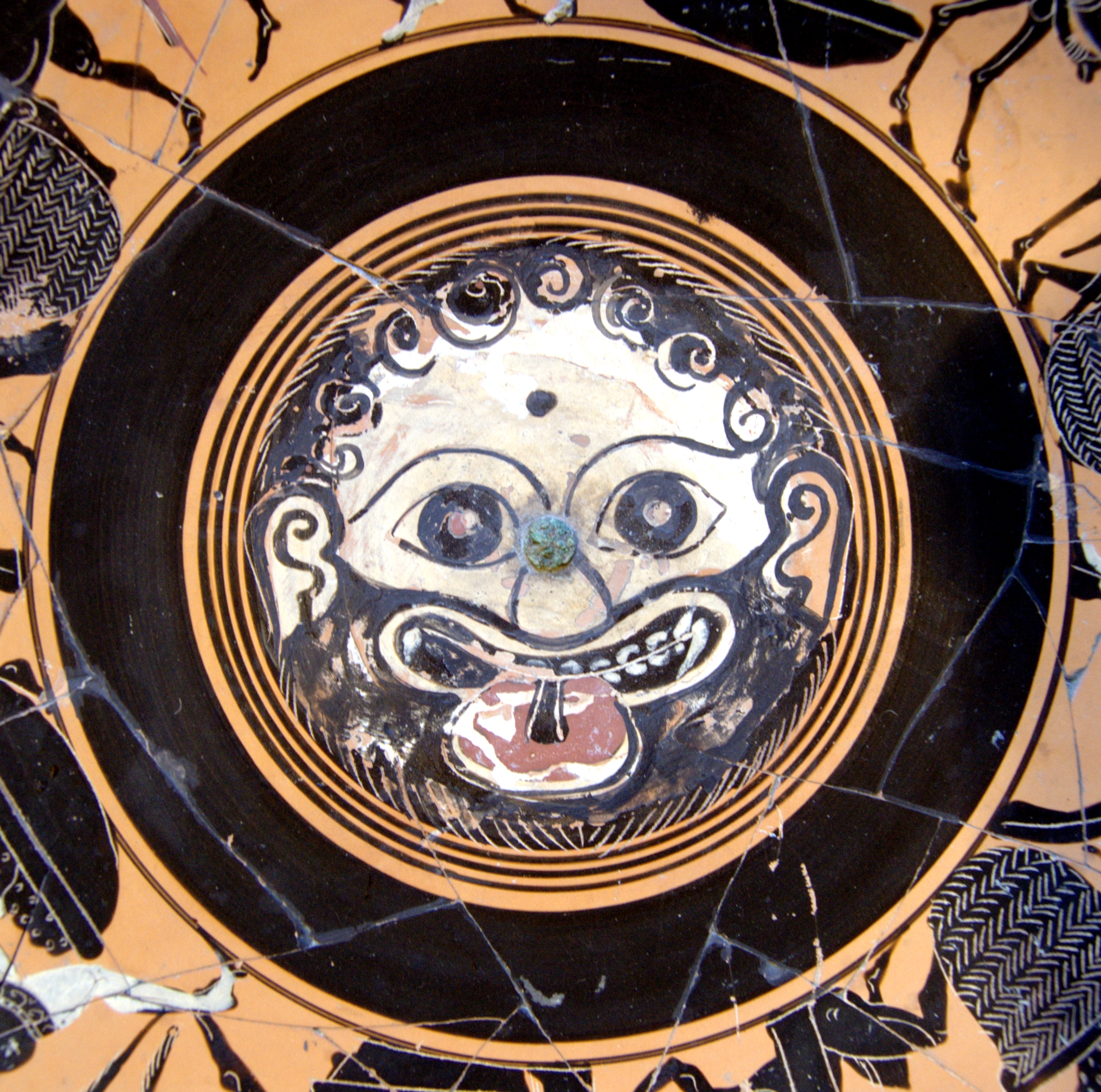|
Ancient Greek Vase Painters
The following is a list of ancient Greek vase painters who have been identified either by name or by style. Because of the research of academics like John Davidson Beazley, Arthur Dale Trendall, Robert Manuel Cook, Darrell A. Amyx and Conrad Stibbe more than 2800 individual painters are known. Geometric period * Dipylon Master Orientalizing period *Analatos Painter * Honolulu Painter * Mesogeia Painter Black-figure period * Acheloos Painter * Affecter * Amasis Painter * Ampersand Painter * Anakles *Andokides Painter * Antimenes Painter * Athena Painter * Beldam Painter * Bellerophon Painter * Castellani Painter * Cerameicus Painter * Chimera Painter * Chiusi Painter * Daybreak Painter * Diosphos Painter * Edinburgh Painter * Elbows Out * Ergoteles * Eucharides Painter * Euphiletos Painter * Exekias * Gela Painter * Goltyr Painter * Gorgon Painter * Haimon Painter * Heidelberg Painter * Kleitias * KX Painter * Lion Painter * Lydos *Lysippides Painter * Madrid Painter ... [...More Info...] [...Related Items...] OR: [Wikipedia] [Google] [Baidu] |
Ancient Greek Vase Painting
Pottery, due to its relative durability, comprises a large part of the archaeological record of ancient Greece, and since there is so much of it (over 100,000 painted vases are recorded in the Corpus vasorum antiquorum), it has exerted a disproportionately large influence on our understanding of Greek society. The shards of pots discarded or buried in the 1st millennium BC are still the best guide available to understand the customary life and mind of the ancient Greeks. There were several vessels produced locally for everyday and kitchen use, yet finer pottery from regions such as Attica was imported by other civilizations throughout the Mediterranean, such as the Etruscans in Italy.John H. Oakley (2012). "Greek Art and Architecture, Classical: Classical Greek Pottery," in Neil Asher Silberman et al. (eds), ''The Oxford Companion to Archaeology, Vol 1: Ache-Hoho'', 2nd Edition, 641–644. Oxford & New York: Oxford University Press. , p. 641. There were a multitude of specif ... [...More Info...] [...Related Items...] OR: [Wikipedia] [Google] [Baidu] |
Antimenes Painter
The Antimenes Painter was an Attica, Attic vase painter of the black-figure vase painting, black-figure style, active between circa 530 and 510 BC. The real name of the Antimenes Painter is not known; his current name is an archaeological convention, derived from the Kalos inscription on a ''hydria'' in Rijksmuseum van Oudheden, the archaeological museum of Leyden. Of the 150 works ascribed to him, ''The Antimenes Painter decorated vases in the black-figure technique in Athens from about 530 to 510 B.C. Working in a period when many artists were switching to the new red-figure technique, the Antimenes Painter was one of the most prolific black-figure artists of his time. Over 140 of his vases survive, mostly amphorae and hydriai. He decorate ... [...More Info...] [...Related Items...] OR: [Wikipedia] [Google] [Baidu] |
Eucharides Painter
Eucharides Painter () is the common nickname of an ancient Greek artist who decorated but did not sign Attic vases. Neither his real name, nor the dates of his birth and death are known. Presumably this artist was a pupil of the Nikoxenos Painter. The name was introduced in 1911 by John Beazley, a classical historian at the University of Oxford, who had a special interest in Attic vases. Through close examination of stylistic details, Beazley and other scholars recognized pieces painted by the same artist. In this case, the nickname appreciates the anonymous painter's repeated use of kalos inscriptions praising the beauty of a named young boy. A vase with the inscription ΚΑΛΟΣ ΕΥΧΑΡΙΔΕΣ ("kalos Eucharides", i.e. Eucharides is beautiful) became the source of the artist's name. The Eucharides Painter was working in Athens in the years from about 500 BC to 470 BC. At this time the technique of vase painting switched from black-figure to red-figure illustrations, a pro ... [...More Info...] [...Related Items...] OR: [Wikipedia] [Google] [Baidu] |
Ergoteles (potter)
Ergoteles (Έργοτέλης) was a Greek potter, active in Athens around the middle of the 6th century BC. He was the son of the famous potter Nearchos and the brother of Tleson. Three signed Little-master cups by him are known: * Berlin, Antikensammlung F 1758 * Florence, arts trade * Oxford, Ashmolean Museum G 1004 Bibliography * John Beazley Sir John Davidson Beazley (; 13 September 1885 – 6 May 1970) was a British classical archaeologist and art historian, known for his classification of Attic vases by artistic style. He was professor of classical archaeology and art at the U ...: ''Attic Black-Figure Vase-Painters'', Oxford 1956, p. 162. * Künstlerlexikon der Antike I, München, Leipzig 2001, p. 213-214 s.v. Ergoteles (Rolf Blatter) External links Ergoteles in the Beazley Archive Ancient Greek potters Artists of ancient Attica 6th-century BC Athenians {{AncientGreece-bio-stub ... [...More Info...] [...Related Items...] OR: [Wikipedia] [Google] [Baidu] |
Elbows Out
Elbows Out is the name given to an Attic black-figure vase painter, active in Athens around 550/540 to 520 BC. His conventional name is derived from the strongly exaggerated gestures and odd anatomy of his dancing figures. Together with the Affecter, he is considered one of the Mannerists of the black-figure style. He painted e.g. lip cups (which classifies him as a Little master) and neck amphorae, the latter in a special shape with a heavy ovoid body. His amphorae are decorated with several friezes. His band cups resemble works by Tleson and Lydos, but are more conventional in terms of the animal motifs. He also painted a '' lydion'', a vase shape very rarely produced by Attic potters. He is often seen as connected with the Affecter, but also with the Amasis Painter. The link with the latter should not be overestimated. He rarely painted mythological scenes, but had a penchant for erotic motifs, as can be seen in his unusually shaped ''hydria The hydria (; : hydriai ... [...More Info...] [...Related Items...] OR: [Wikipedia] [Google] [Baidu] |
Edinburgh Painter
The Edinburgh Painter was an Attic black-figure vase painter, active around 500 BC. His speciality was white-ground ''lekythoi'' painted in the black-figure style. His real name is unknown. His conventional name is derived from his name vase in Edinburgh, National Museum of Scotland 1956.436. Gallery Image:NAMA Pélée, Achille & Chiron.jpg, ''Lekythos'', Peleas, Achilles and Cheiron, Athens, National Museum 550 Image:NAMA Thésée & taureau.jpg, ''Lekythos'', Theseus and the bull, Athens, National Museum 1124 Image:NAMA Ulysse & sirène 1.jpg, ''Lekythos'', Odysseus and a siren, Athens, National Museum 1130 Image:Edinburgh P 1872.23.12.JPG, Name vase, Edinburgh, National Museums of Scotland MoS 1872.23.12 Bibliography * C. H. Emilie Haspels: ''Attic black-figured lekythoi'', Paris 1936, p. 86-89. 215-221. * John Beazley: ''Attic Black-Figure Vase-Painters'', Oxford 1956, p. 476-480. * John Boardman: ''Schwarzfigurige Vasen aus Athen. Ein Handbuch'', Mainz 1977, , ... [...More Info...] [...Related Items...] OR: [Wikipedia] [Google] [Baidu] |
Diosphos Painter
The Diosphos Painter was an Athenian Attic black-figure vase painter thought to have been active from 500–475 BCE, many of whose surviving works are on lekythoi. The Diosphos Painter was a pupil of the Edinburgh Painter, who also trained the Sappho Painter. He was first identified by C.H.E. Haspels in her ''Attic Black-figure Lekythoi'' (Paris, 1936). See also * List of Greek vase painters The following is a list of ancient Greek vase painters who have been identified either by name or by style. Because of the research of academics like John Davidson Beazley, Arthur Dale Trendall, Robert Manuel Cook, Darrell A. Amyx and Conrad ... External links Works by the Diosphos Painterat the Metropolitan Museum of Art {{Authority control Ancient Greek vase painters Archaic Greek art Ancient Athenians ... [...More Info...] [...Related Items...] OR: [Wikipedia] [Google] [Baidu] |
Daybreak Painter
The Daybreak Painter was an Attic black-figure vase painter, active in the late sixth and early fifth centuries BC. His real name is not known. He was of the Leagros Group and painted primarily ''lekythoi'' and '' oinochoai'' as well as the newly introduced '' olpe''. His work is characterised by a highly developed sense of colour and a good hand for detail. Haspels gave him the name of Daybreak Painter after his ''lekythos'' which depicted the god Helios emerging from the sea. See also * Little Masters (Greek vase painting) * List of Greek vase painters Bibliography * John Beazley Sir John Davidson Beazley (; 13 September 1885 – 6 May 1970) was a British classical archaeologist and art historian, known for his classification of Attic vases by artistic style. He was professor of classical archaeology and art at the U ...: ''Attic Black-figure Vase-painters''. Oxford 1956, p. * John Boardman: ''Schwarzfigurige Vasen aus Athen. Ein Handbuch'', von Zabern, 4. edn, ... [...More Info...] [...Related Items...] OR: [Wikipedia] [Google] [Baidu] |
Chiusi Painter
The Chiusi Painter was an Attica, Attic black-figure vase painting, black-figure vase painter, active in the last quarter of the sixth century BC. His real name is not known. The Chiusi Painter was part of the so-called Leagros Group, the last major important group of painters in the black-figure style. He is characterised by what John Boardman (art historian), John Boardman calls a "boring delicateness"John Boardman (art historian), John Boardman: ''Schwarzfigurige Vasen aus Athen'', p. 121 compared to other artists of the group, failing to reach the standards of the Acheloos Painter for example. See also * List of Greek vase painters Bibliography * John Boardman (art historian), John Boardman: ''Schwarzfigurige Vasen aus Athen. Ein Handbuch'', Mainz 1977, , p. 121 References [...More Info...] [...Related Items...] OR: [Wikipedia] [Google] [Baidu] |
Chimera Painter
The Chimera Painter (also spelled Chimaera Painter) was an anonymous Corinthian black figure vase painter active c. 600–575 BC. He is named for the Chimera depicted on one of his works, which is now in Vienna. The artist was likely a student of the Columbus Painter, who in turn was a student of the Painter of Palermo 489. His work displays strong Near Eastern influence; the influence of Assyrian art Assyrian sculpture is the sculpture of the ancient Assyrian states, especially the Neo-Assyrian Empire of 911 to 612 BC, which was centered around the city of Assur in Mesopotamia (modern-day Iraq) which at its height, ruled over all of Mesopo ... is particularly visible in his depictions of lions.* References External links * ''Plate with Seated Lioness''on Google Arts and Culture ''Corinthian Round-Bodied Pyxis'' c. 570 B.C. attributed to the Chimera Painter.in the online catalog of the Getty Museum {{Greek vase painters Ancient Greek vase painters Ancient Corinthians ... [...More Info...] [...Related Items...] OR: [Wikipedia] [Google] [Baidu] |
Cerameicus Painter
The Cerameicus Painter (also Kerameikos Painter) was one of the first Attic black-figure vase painters. He was active around 600 BC. The Cerameicus Painter can be placed stylistically between the Nessos Painter and the Gorgon Painter; he is probably chronologically closer to the latter. He was less productive than the Gorgon Painter and painted in a simple yet fluid style. His name is based on his name vase, found in the Kerameikos of Athens. That vase is an '’ olpe’’ and can be considered exemplary of the vase painting of its time. The vase is subdivided into several zones of animal friezes. In the upper area, a single mythological figure is flanked by two lions, the latter a popular motif at the time. See also * List of Greek vase painters Bibliography * John Beazley Sir John Davidson Beazley (; 13 September 1885 – 6 May 1970) was a British classical archaeologist and art historian, known for his classification of Attic vases by artistic style. He was professor ... [...More Info...] [...Related Items...] OR: [Wikipedia] [Google] [Baidu] |
Castellani Painter
The Castellani Painter was an Attic vase painter of the black-figure style active in the second quarter of the sixth century BC. The Castellani Painter is especially well known for his drawings on Tyrrhenian amphorae, of which he is considered the most significant painter. His work is distinguished by the use of a vegetal frieze above to animal friezes, as well as by his humorous depictions of large-headed humans and mythical creatures. His conventional name is derived from his name vase, once held in the Castellani Collection. See also * List of Greek vase painters Bibliography * John Beazley Sir John Davidson Beazley (; 13 September 1885 – 6 May 1970) was a British classical archaeologist and art historian, known for his classification of Attic vases by artistic style. He was professor of classical archaeology and art at the U ...: ''Attic Black-Figure Vase-Painters'', Oxford 1956, p. 94-106. * John Boardman: ''Schwarzfigurige Vasen aus Athen. Ein Handbuch' ... [...More Info...] [...Related Items...] OR: [Wikipedia] [Google] [Baidu] |





